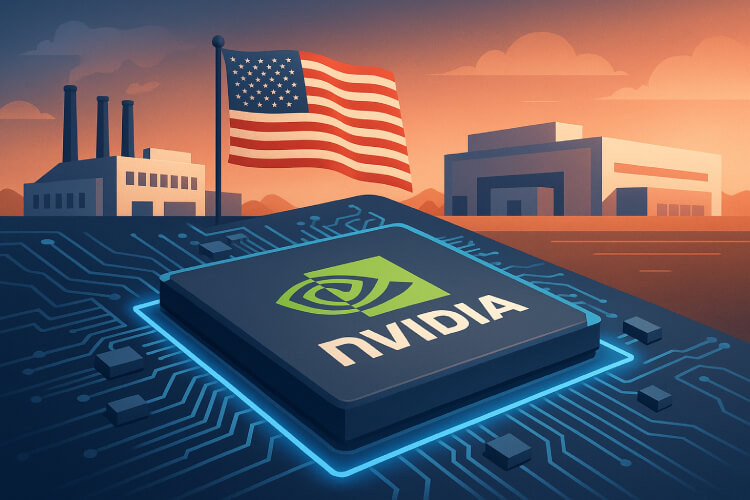NVIDIA Manufacturing Supercomputers in the US at Scale
Insights | 09-06-2025 | By Robin Mitchell

Key Takeaways:
- NVIDIA to manufacture AI supercomputers entirely in the US — partnering with TSMC, Amkor, Foxconn and others, with large-scale facilities underway in Arizona and Texas.
- Up to $500 billion in AI infrastructure planned — NVIDIA expects volume production of Blackwell chips by late 2025, supporting the global shift toward domestic AI compute capability.
- US-based manufacturing driven by supply chain risk, not tariffs — long-term geopolitical pressures and export controls have shaped this move more than economic protectionism.
- Reshoring remains a complex challenge — cost pressures, cultural expectations, and lost industrial knowledge continue to hinder broad Western manufacturing recovery.
Calls to revitalise American manufacturing have grown louder in recent years, spurred on by shifting geopolitics, pandemic-era supply chain chaos, and renewed interest in domestic resilience. Among the most polarising tools in this push: tariffs. Supporters hail them as a blunt but effective way to bring jobs back home. Detractors argue they disrupt trade and raise costs without solving core issues.
But what if the real reasons behind Western manufacturing decline have little to do with tariffs at all?
What structural forces are shaping the industrial landscape, why is reshoring easier said than done, and how does NVIDIA’s billion-dollar bet on US-based AI supercomputers fit into the bigger picture?
The Manufacturing Challenge
The latest round of tariffs under President Trump has once again thrown fuel on the fire of the long-standing debate over domestic manufacturing. On one side, you have those cheering the decision as a bold step toward reclaiming American industry. On the other hand, globalist critics warn of impending economic doom, rattling off every macroeconomic metric they can find on Bloomberg.
But here's the blunt truth, and it's one that both sides often miss: Western manufacturing isn't struggling because of a lack of tariffs. It's struggling because the world has changed, and we've changed with it.
Globalisation and the Economics of Outsourcing
Let's start with the most obvious issue: cost. For decades, Western economies have happily outsourced their manufacturing to countries like China, chasing lower wages, looser regulations, and scalable labour, all so that consumer products could be made highly competitive. As Western economies grew (with the workforce moving into service-based industries), people found that they had far more disposable income than ever, making this transition even more effective. With a global economy that has worked like this for more than 30 years, slapping on a few tariffs and waving a flag will not give rise to a manufacturing renaissance.
And that brings us to point number two: expectations. In emerging economies, working on a factory line is a path to prosperity. In the West? It's considered a dead-end job, no matter the salary. We've told our kids for decades to "do better," to get degrees, and to avoid manual labour. So when policymakers talk about "bringing jobs back," the reality is that very few want to do those jobs.
Cultural Perception and the Decline of Industrial Skills
Third, we have a serious knowledge gap, and this one is seriously underappreciated. Mass manufacturing isn't just about machines and manpower. It's about process optimisation, supply chain coordination, and quality control at scale. These are skills that were developed, refined, and perfected in overseas markets over decades. You can't just will them back into existence with policy. In many cases, we've forgotten how to make things, at least, how to make them cheaply and at scale.
Lastly, there's the cold, hard reality of logistics and capital. Building a factory isn't like opening a food truck. It takes time, land, machinery, trained staff, compliance certifications, and, of course, money. And even when you've got all that lined up, you still need a customer base willing to pay 30–50% more for the same product, all in the name of patriotism. Spoiler: most won't.
Now, none of this is to say that reshoring manufacturing is a bad idea. Quite the opposite, it's a goal worth pursuing. But it has to be done with a clear head, not empty slogans. It'll require automation, education, strategic investment, and a long-term commitment to rebuilding lost expertise. It's a generational effort, not an election cycle soundbite.
NVIDIA Manufacturing Supercomputers in the US
In a headline-grabbing move, NVIDIA announced that it will be manufacturing AI supercomputers entirely in the United States. This development comes as a result of the company's partnership with several key firms, including TSMC, Amkor, and Foxconn. Production of NVIDIA Blackwell chips has already begun at TSMC's new facility in Phoenix, Arizona, but only as pilot lots. NVIDIA expects volume production to ramp to 25–30 k wafers per month in Q4 2025, with a second, more advanced fab (3 nm / 2 nm) slated for 2028.
Building AI Infrastructure at Scale
According to Jensen Huang, NVIDIA’s CEO, the shift towards domestic production is more than just a capacity expansion — it reflects a broader strategic need to build AI infrastructure where the demand resides. “The engines of the world’s AI infrastructure are being built in the United States for the first time,” Huang stated, highlighting a renewed emphasis on geographic alignment between data centres and their manufacturing pipelines.
The company still touts an ambitious headline number: up to half a trillion US dollars of AI infrastructure manufactured in America. However, phase-one capital expenditure is pegged at US $48 billion through FY-2027, with the full $500 billion target spread over roughly the next decade rather than four years.
The company’s ramp-up in US-based production includes the commissioning of over one million square feet of space across multiple states. Manufacturing sites in Arizona (with TSMC and Amkor) and Texas (with Foxconn and Wistron) are expected to deliver full-stack AI systems, from wafer fabrication to system-level testing, within 12–15 months. This reflects a shift from piecemeal global sourcing to a vertically integrated, domestically anchored supply chain.
NVIDIA's decision dovetails with its goal of producing the most powerful AI chips available while reducing supply-chain risk. It also lands amid tighter US export controls: on 14 April 2025, the White House required an individual export licence for every shipment of H20 data centre GPUs to China. In response, NVIDIA is designing a downgraded "H20-Lite" model to meet the rules while serving that market.
The export licensing requirements, while restrictive, have pushed NVIDIA to adapt quickly with product variants like the H20-Lite. Yet the longer-term play appears to be in reducing exposure altogether. Localised chip production supports regulatory compliance, but also reinforces the company’s posture around supply-chain sovereignty — a term increasingly associated with national AI competitiveness.
The partnership among NVIDIA, TSMC, Amkor, and Foxconn is expected to create about 70,000 direct jobs and roughly 300,000 indirect jobs over the coming decade. The company has already commissioned more than one million square feet of space for back-end packaging, assembly, and final-test operations.
Strengthening Supply Chain Resilience Through Localisation
NVIDIA is leveraging its own technologies to optimise factory performance. Tools such as NVIDIA Omniverse are being deployed to create digital twins of facilities, enabling predictive modelling and layout optimisation before physical construction is complete. In parallel, AI-driven robotics powered by NVIDIA Isaac GR00T will handle precision automation tasks across the manufacturing floor, reducing reliance on manual processes while improving throughput consistency.
The production of AI supercomputers in US facilities will strengthen NVIDIA's position in the market and help meet soaring demand for AI infrastructure across industries.
These developments align with the growing global shift towards building so-called “AI factories” — data centres purpose-built to train and deploy machine learning models at scale. By manufacturing both the compute engines and the complete systems on US soil, NVIDIA aims to harden its supply chain against external disruptions while boosting local economic resilience. If successful, this model could serve as a blueprint for future sovereign AI infrastructure in other nations as well.
Does This Move by NVIDIA Prove Tariffs Work? Not Quite
It won't take long for some to claim NVIDIA's decision to manufacture AI supercomputers in the US as a vindication of Trump‑era tariffs. On the surface, it's an easy narrative, impose economic pressure, bring jobs home, and rebuild American industry. But that's not what's happening here.
This move isn't the result of a few policy tweaks or tariff hikes. It's the product of years, if not decades, of slow‑burning geopolitical pressure and the very real need for supply‑chain stability. Semiconductor manufacturing, especially at the bleeding edge, doesn't just pivot overnight. Companies like NVIDIA don't decide to break ground on US manufacturing facilities in response to a headline; they do it after extensive forecasting, market analysis, and discussions with partners who control multi‑billion‑dollar fabs.
In fact, tariffs, especially blanket ones, could easily work against this kind of initiative. Electronics supply chains are a spider web of global interactions. A single chip might pass through a dozen countries before the final assembly. When tariffs are slapped across broad categories of components, materials, or sub‑assemblies, it becomes nearly impossible to navigate sourcing without taking a financial hit. That's not efficiency. That's economic drag.
NVIDIA's move is more likely the result of rising friction with China and its neighbouring manufacturing hubs. The risk of over‑reliance on unstable or adversarial regions has become too great. Add to that USS export controls on advanced chips and a broader push for "AI sovereignty," and you begin to see why domestic manufacturing became more attractive, not because of tariffs, but in spite of them.
Yes, this will benefit the US economy in terms of job creation, tech leadership, and infrastructure. But to say it signals a manufacturing renaissance is premature.
And let's not ignore the elephant in the room: if tariffs continue to escalate or are poorly targeted, they could jeopardise this entire effort. Collapse global trade routes, disrupt access to critical tools or materials, or destabilise allied economies, and you don't get more jobs in America. You get stalled factories, higher costs, and fewer chips.
This is not a win for tariffs. It's a win for long‑term planning, risk mitigation, and technological self‑preservation. Let's give credit where it's due, to strategic foresight, not economic blunt force.

